Key takeaways:
- Nature journaling enhances mindfulness and fosters a deeper connection with the environment, encouraging detailed observation and personal reflection.
- The practice cultivates empathy for wildlife, inspiring participants to advocate for animal protection and conservation efforts.
- Workshops that incorporate creative activities, sensory engagement, and thematic exploration enhance participants’ emotional connections and reflections on nature.
- Sharing experiences and artworks within workshops builds community and enriches individual journaling practices, promoting a supportive environment for self-expression.
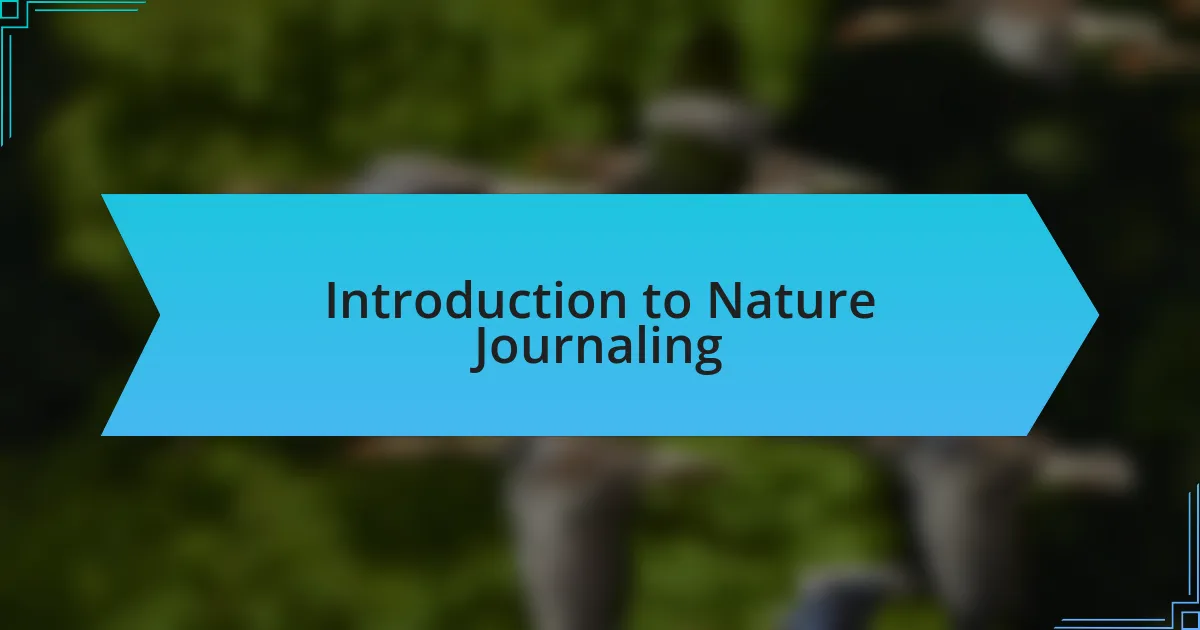
Introduction to Nature Journaling
Nature journaling is more than just a creative pastime; for me, it’s a doorway to deeper awareness. I still remember the first time I sat quietly under an old oak tree, pencil in hand, capturing the delicate dance of leaves in the wind. That simple act grounded me and sparked my curiosity about the world around me.
Have you ever noticed how time seems to slow down when you immerse yourself in nature? I found that nature journaling invites this kind of mindful presence, allowing me to pick up on details I often overlook. Whether it’s the intricate patterns on a butterfly’s wings or the subtle shifts in light throughout the day, documenting these experiences fosters a connection to the natural world that is both enlightening and cathartic.
It’s fascinating how this practice can enhance our understanding of ecosystems and conservation efforts. I often encourage participants to observe not just the beauty of nature but also its challenges. By reflecting on our experiences through journaling, we can cultivate empathy for the creatures we share this planet with, inspiring us to advocate for their protection in a more profound way.
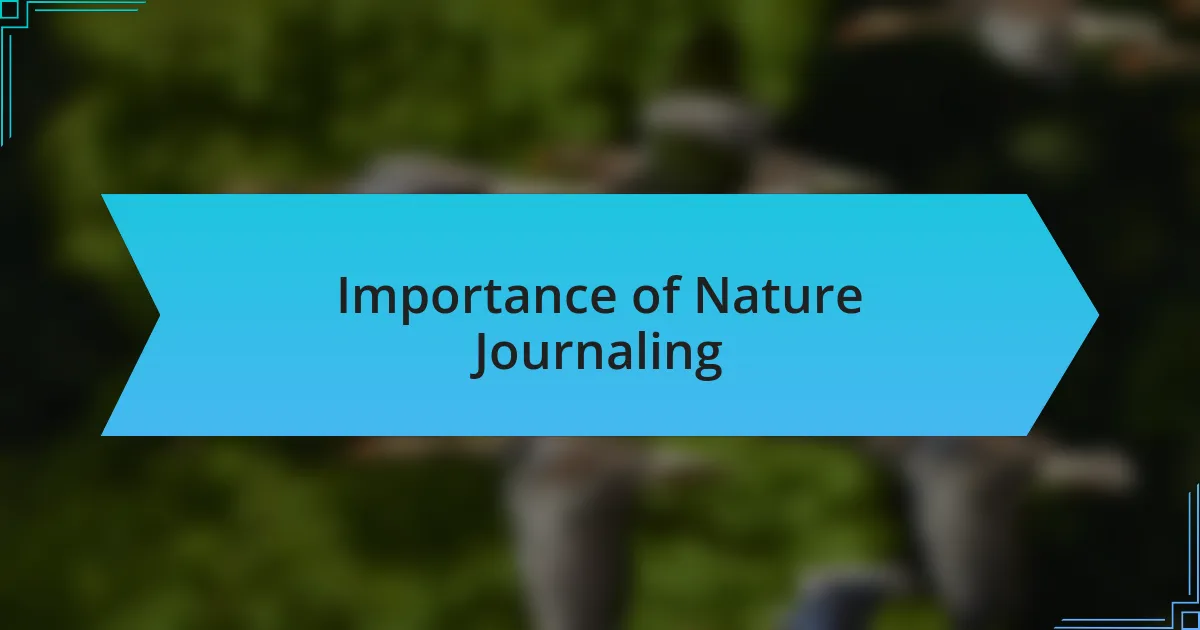
Importance of Nature Journaling
Nature journaling serves as a powerful tool for fostering a deeper relationship with the environment. I remember one particular afternoon spent sketching a winding river; the act of documenting its curves and colors transformed my appreciation for its role in the ecosystem. It became clear to me how journaling not only records beauty but also highlights the interconnectedness of all living things.
When I guide others in nature journaling, I can see the spark of realization in their eyes as they begin to observe the small details that often go unnoticed. It brings to mind the shattered remains of a bird’s nest I found once; each fragment told a story of resilience and loss. It challenges us to ask ourselves: how does our perception of nature shift when we actively engage with it, rather than merely pass by?
This practice encourages creativity and reflection, enhancing our capacity for critical thinking about environmental issues. In trying to capture the essence of a blooming flower, I often reflect on its role in the ecosystem, its fragility, and the importance of protecting such treasures. Nature journaling empowers us not just to observe but to feel compelled to act on behalf of the world we love.
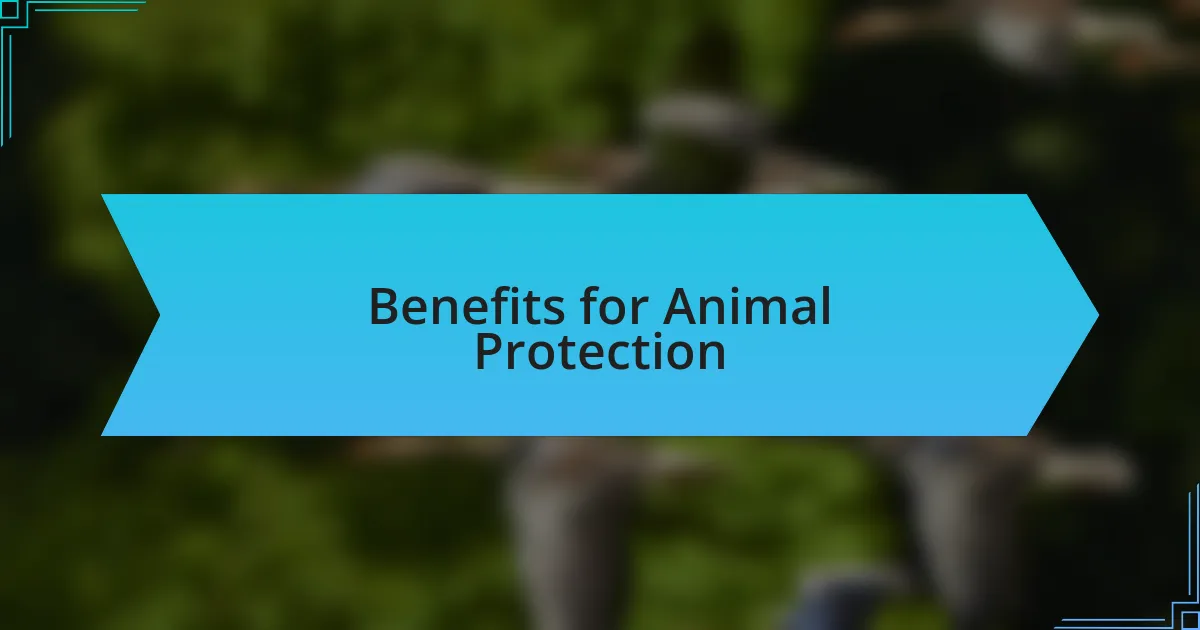
Benefits for Animal Protection
The benefits of nature journaling extend far beyond personal reflection; they significantly aid animal protection efforts. As participants immerse themselves in the details of a habitat, I often witness them connecting emotionally with the wildlife that resides there. One memorable instance involved a workshop where someone expressed a newfound love for a rare bird species after closely observing its behavior. That moment showed me how journaling fosters empathy, leading individuals to advocate for species preservation.
When people actively document their observations, it sharpens their awareness of the environmental challenges faced by animals. I recall a participant who became alarmed after sketching the effects of pollution on a nearby stream. This prompted discussions about local conservation initiatives, igniting the passion for change. It’s a powerful reminder that through journaling, we not only capture moments but also generate a desire to protect the habitats and lives of those we come to cherish.
Moreover, nature journaling serves as a bridge between personal growth and activism. By sharing their journals, individuals inspire others to take action, creating a ripple effect within their communities. I’ve seen firsthand how a simple drawing of an endangered species can lead to an organized effort to support wildlife conservation programs. It makes me wonder: what if more people used their creativity to advocate for animal protection?
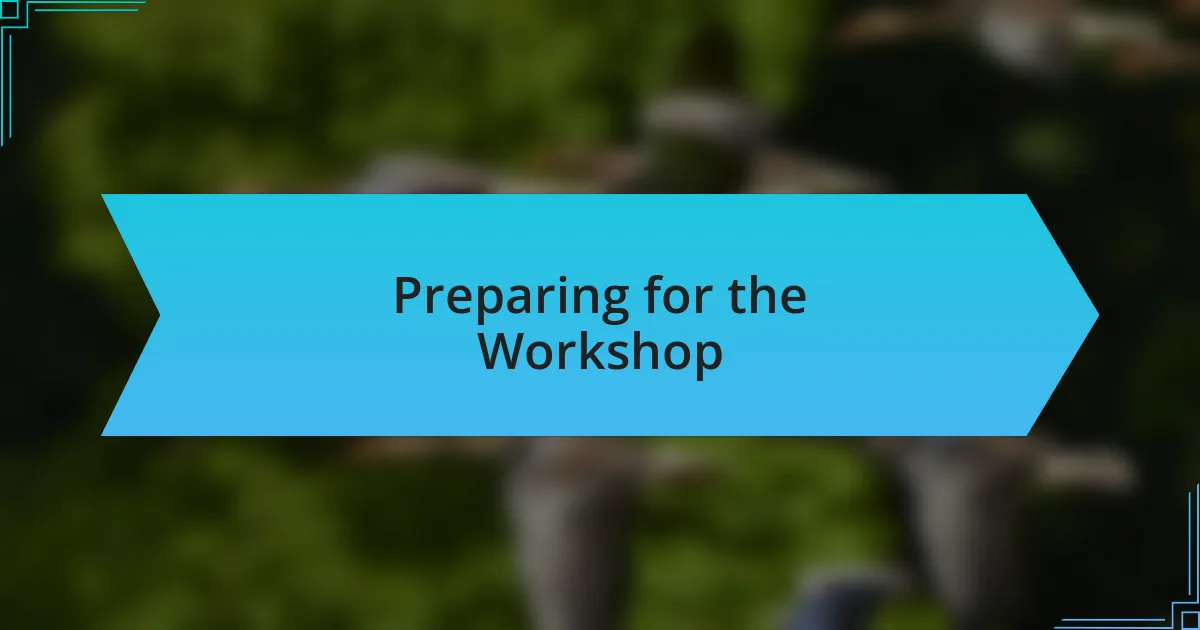
Preparing for the Workshop
Preparing for a workshop requires careful planning to ensure a meaningful experience for all involved. I remember the excitement I felt while gathering the right materials—sketchbooks, colored pencils, and guides on local wildlife—each item essential for inspiring participants. Setting up the space outdoors is crucial too; a serene environment naturally enhances creativity and promotes deeper connections with nature.
I find that the workshop’s success hinges on building a welcoming atmosphere. One time, I brought in various natural artifacts like feathers and leaves to spark curiosity before the journaling began. As participants handle these items, their eyes light up, and the connection to the environment starts blooming. How can we expect to engage with nature if we don’t first touch and examine its wonders?
Finally, I always prepare a bit of background on local ecosystems to share during the workshop. It’s fascinating how a brief discussion on the interconnectedness of species can ignite a participant’s passion for conservation. For example, I once shared how the decline of a single insect can affect an entire food chain. Seeing their reactions, it becomes clear: understanding leads to caring, and caring leads to advocacy.
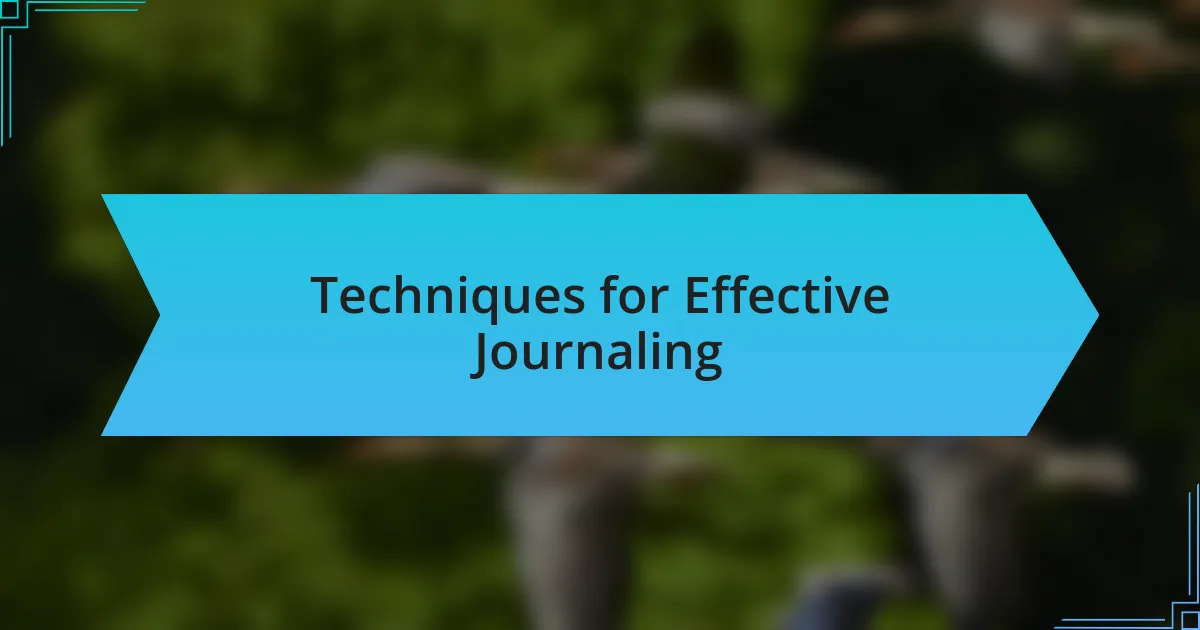
Techniques for Effective Journaling
One effective technique for nature journaling is to engage all your senses. I remember a particularly vibrant session where I encouraged participants to close their eyes and just listen. The rustling leaves, chirping birds, and distant water flow became a symphony that inspired vivid descriptions and sketches in their journals. This practice not only deepens their observation but also fosters a stronger emotional connection to the surroundings.
I often emphasize the importance of free writing in a journal. During one workshop, I invited everyone to jot down their thoughts for just five minutes without worrying about spelling or grammar. This led to unexpected reflections, like one participant who revealed a deep love for a nearby forest, describing it as a safe haven during tough times. It struck me how liberating it can be to express oneself without self-judgment, and I encourage this practice to help uncover personal narratives intertwined with nature.
Lastly, sketching should be viewed as an essential part of the journaling experience, not just an addition. I vividly recall guiding a participant who felt intimidated by drawing—she made a simple outline of a butterfly and, by the end of the session, added intricate details that reflected her growing confidence. This transformation highlighted how sketching can serve as both a creative outlet and a form of meditation. What better way to imprint the beauty of nature in our memories than by capturing it through art?
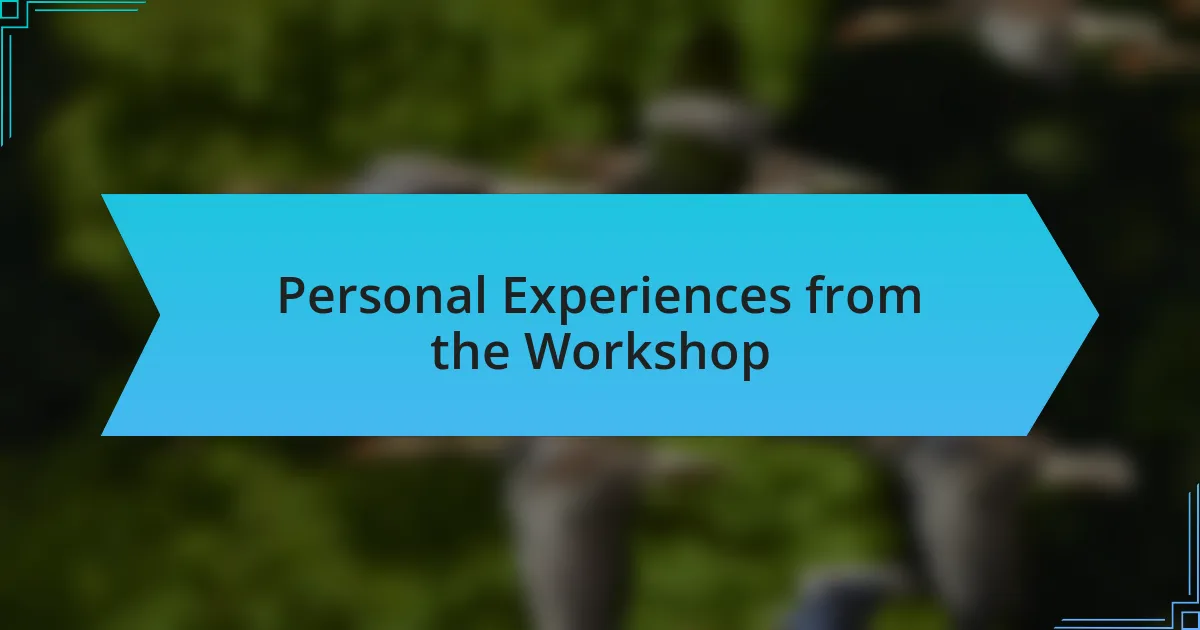
Personal Experiences from the Workshop
During the workshop, one moment that especially resonated with me was when a participant shared her experience of journaling under an ancient oak tree. As she described the tree’s gnarled roots and whispering leaves, I could see how her words were infused with a sense of belonging. It made me wonder how often we overlook the stories nature longs to tell us, and how journaling can reveal those hidden narratives.
Another participant surprised herself when she found a new way to express her feelings about a recent loss. She would sketch the sunset, colors rippling across the sky, and wrote about how it mirrored her own journey of healing. Watching her transform her grief into art was a poignant reminder that nature has the power to comfort us and encourage vulnerability.
One workshop highlight was when we collectively sat in silence for a few moments before starting our entries. This shared stillness created an unspoken bond among us, making each individual’s observations feel just a little more significant. I’ve come to realize that these quiet sessions foster not only self-reflection but also a sense of community in our appreciation for nature’s wonders. How often do we take a moment to pause and truly connect, not just with nature but with each other?
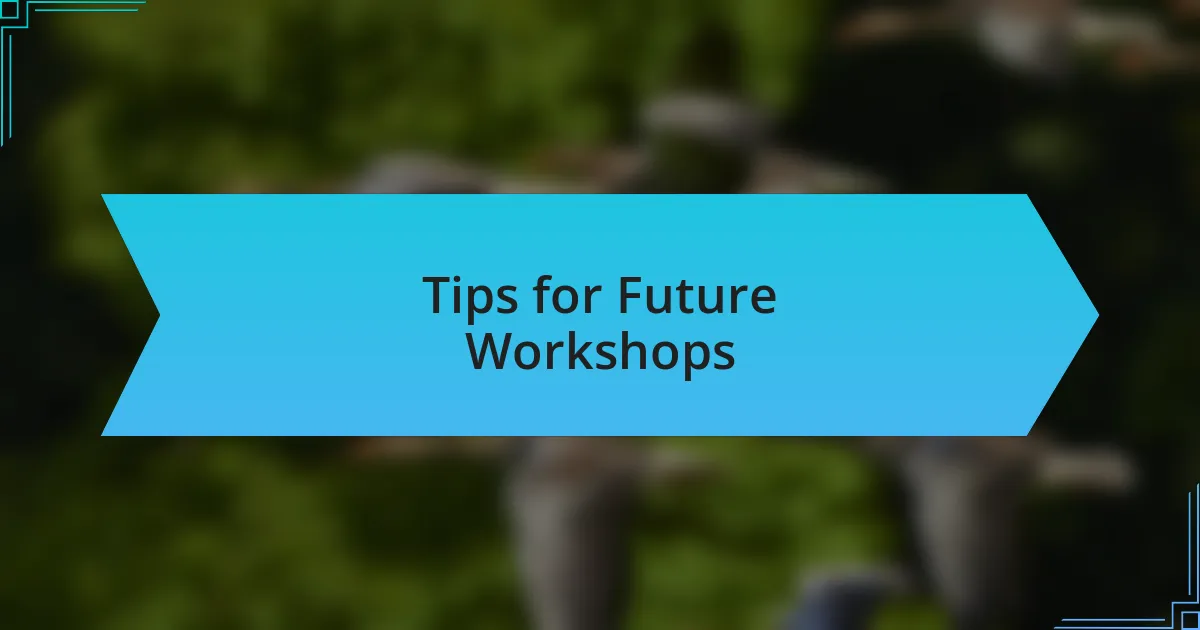
Tips for Future Workshops
Planning future workshops can greatly benefit from some practical tips. One approach that worked well for me was to incorporate a theme for each session. For instance, focusing on the changing seasons allowed participants to explore contrasting emotions tied to nature’s cycles. How does the transition from spring to winter resonate with you personally? This thematic unity can guide participants in their journaling, creating a rich tapestry of shared experiences.
Another tip I’d recommend is to encourage sharing among participants. I vividly recall when one person read aloud a beautifully written piece about the resilience of a blooming wildflower. Her reading sparked a round of discussions that added layers of meaning to everyone’s journals. Can you imagine the depth this connection can bring to your workshop? It truly creates an atmosphere where everyone feels comfortable expressing their thoughts and emotions.
Lastly, consider integrating art supplies alongside journaling materials. In my workshop, offering colored pencils and watercolors allowed participants to visualize their observations in a new way. One participant, who initially felt hesitant about writing, found freedom in sketching a local bird – and that led to a written reflection that surprised even her. How could integrating more creative outlets transform your participants’ experiences? By blending art with journaling, you open doors to new ways of expression that enrich the overall workshop.